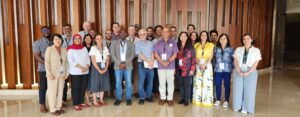
CGIAR has launched a major new crop-focused global breeding research program that brings together its rice breeding Centers and national partners to accelerate research developing and delivering better varieties, faster.
Launched at a strategic planning meeting on January 24-25, 2024 in Dubai, UAE, the Global Rice Breeding Program (GRBP) aims to improve the quality of life of small holding rice farmers and consumers in low- and middle-income countries.
The meeting participants agreed to (1) establish a common framework of global market segments, breeding pipelines, product concepts and CGIAR-NARES (national agricultural research and extension services) partners network that will facilitate the implementation of a global CGIAR rice breeding program; (2) identify working teams and their respective responsibilities; (3) establish operating principles to effectively achieve the GRBP objectives; and (4) develop a time-bound work plan to implement the GRBP across the participating Centers – AfricaRice, CIAT, and IRRI.
This project is organized under the auspices of the of the CGIAR Genetic Innovation (GI) Science Group’s Plant Breeding and Pre-Breeding unit. With full endorsement and support from GI leadership for the mission, vision, and operating principles for the GRBP, Directors General of the three participating CGIAR Centers and the GI leadership signed a Letter of Understanding (LoU), agreeing to basic guidelines for operating the global program.

“GRBP is a mechanism to bring together CGIAR’s work on rice breeding towards the common aim of increasing genetic gain in farmers’ fields” said Sonja Vermeulen, GI Managing Director. “It ensures we meet farmers’ and consumers’ needs and respond to future challenges.”
Key to the event was high-level guidance from GI leadership to ensure that GRBP’s integrated approach to rice breeding, across three centers and their partners, is well aligned with CGIAR’s global approaches to partnerships and continuous improvement in crop breeding.
“GRBP contributes to the bigger mission of CGIAR to achieve food security, and to achieve benefits in its target impact areas on climate, environment, gender, nutrition, and poverty,” said John Derera, GI Senior Director for Plant Breeding and Pre-breeding.
Hans Bhardwaj, director of the GRBP, presented the overall framework and operating principles of the GRBP. Details of these operating principles had been developed by teams of scientists prior to the meeting, and were presented for discussion and agreement during the remaining day and a half of the meeting.
GRBP offers the best opportunity to leverage the global capacity, competencies and reach of CGIAR to develop and deliver market needed rice varieties to the smallholding rice farmers in the Global South. The global rice breeding program (GRBP) could provide a model for other crops, Bhardwaj underscored.
Scientists from the three participating Centers attended the meeting, and contributed to the development of the different sections of the GRBP framework and operating mechanism. Also participating were delegates from the CGIAR Breeding Resources Initiative, led by Senior Director Sharifah Shed Alwee; scientists of the Accelerated Breeding Initiative, led by its global lead Michael Quinn; and a representative from the Bill & Melinda Gates Foundation, Gary Atlin.
—–
We would like to thank all funders who support this research through their contributions to the CGIAR Trust Fund. Main photo: Signing of LOU, with representatives from CGIAR Systems Office / Genetic Innovation, IRRI, AfricaRice, CIAT, and Bill and Melinda Gates Foundation.
